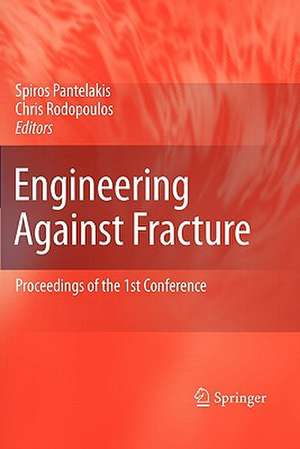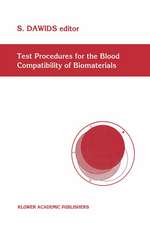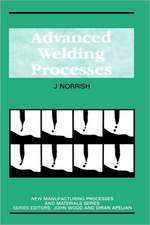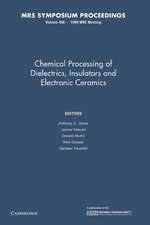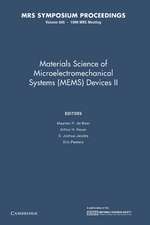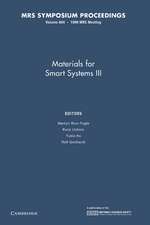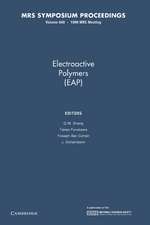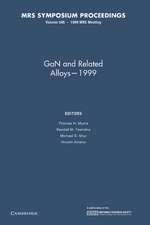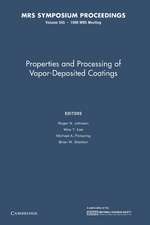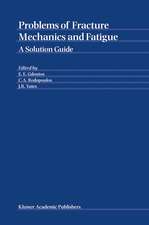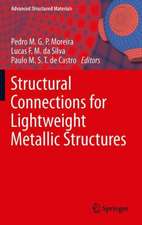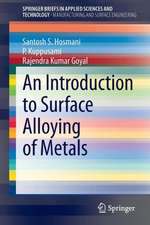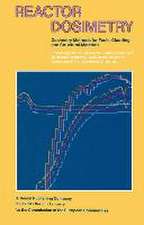Engineering Against Fracture: Proceedings of the 1st Conference
Editat de S. G. Pantelakis, C.A. Rodopoulosen Limba Engleză Paperback – 6 noi 2010
| Toate formatele și edițiile | Preț | Express |
|---|---|---|
| Paperback (1) | 951.49 lei 6-8 săpt. | |
| SPRINGER NETHERLANDS – 6 noi 2010 | 951.49 lei 6-8 săpt. | |
| Hardback (1) | 961.51 lei 6-8 săpt. | |
| SPRINGER NETHERLANDS – 20 feb 2009 | 961.51 lei 6-8 săpt. |
Preț: 951.49 lei
Preț vechi: 1160.36 lei
-18% Nou
Puncte Express: 1427
Preț estimativ în valută:
182.23€ • 187.75$ • 152.65£
182.23€ • 187.75$ • 152.65£
Carte tipărită la comandă
Livrare economică 24 februarie-10 martie
Preluare comenzi: 021 569.72.76
Specificații
ISBN-13: 9789048181193
ISBN-10: 9048181194
Pagini: 596
Ilustrații: XI, 581 p.
Dimensiuni: 155 x 235 x 31 mm
Greutate: 0.82 kg
Ediția:Softcover reprint of hardcover 1st ed. 2009
Editura: SPRINGER NETHERLANDS
Colecția Springer
Locul publicării:Dordrecht, Netherlands
ISBN-10: 9048181194
Pagini: 596
Ilustrații: XI, 581 p.
Dimensiuni: 155 x 235 x 31 mm
Greutate: 0.82 kg
Ediția:Softcover reprint of hardcover 1st ed. 2009
Editura: SPRINGER NETHERLANDS
Colecția Springer
Locul publicării:Dordrecht, Netherlands
Public țintă
Professional/practitionerCuprins
Ball-Burnishing and Roller-Burnishing to Improve Fatigue Performance of Structural Alloys.- Dual Scale Fatigue Crack Monitoring Scheme Considering Random Material, Geometric and Load Characteristics.- Exploitation of the TRIP Effect for the Development of Formable, Fracture and Fatigue Resistant Steels for Automotive Applications.- Hybrid Metal Laminates for Low Weight Fuselage Structures.- Multifunctional Materials Used in Automotive Industry: A Critical Review.- Engineering Properties.- Effect of Talc Filler Content on Poly(Propylene) Composite Mechanical Properties.- Fracture Properties of Polypropylene Reinforced with Short Glass Fibres: The Influence of Temperature, Notch Length and Geometry.- Influence of Width of Specimen on Tensile Properties of NiCo Thin Film.- Fatigue Damage Physics and Modeling.- Dynamic Properties and Fatigue Failure of Aircraft Component.- Investigation of the Fatigue Behaviour of the Structural Magnesium Alloy AZ31.- Engineering Properties II.- Coulomb Failure Surfaces in Ductile Non Linear Elastic Materials.- Effect of Stress on the Fire Reaction Properties of Polymer Composite Laminates.- Investigation of Failure and Failure Progression in Stiffened Composite Structures.- Next Generation Composite Aircraft Fuselage Materials under Post-crash Fire Conditions.- Progressive Fracture Analysis of Planar Lattices and Shape-Morphing Kagome Structure.- Fatigue Damage (Experimental).- Fatigue Behavior of Non-crimp Fabrics.- Fatigue Crack Growth Assessment of Corroded Aluminum Alloys.- Fatigue Crack Growth Behavior under Spectrum Loading.- Small Crack in a Simulated Columnar Polycrystalline Aggregate with Random 2D and 3D Lattice Orientations.- Thermo-Mechanical Methods for Improving Fatigue Performance of Wrought Magnesium Alloys.- Applied Fracture Mechanics.- Investigations on Fracture of Collector Copper Lamellas.- The Regularities of Fatigue Crack Growth in Airframes Elements at Real Operation Conditions.- Engineering Applications.- Fracture in Electronics.- Improving the Crashworthiness of Aluminium Rail Vehicles.- Information Fusion in Ad hoc Wireless Sensor Networks for Aircraft Health Monitoring.- Roll Forming of AHSS: Numerical Simulation and Investigation of Effects of Main Process Parameters on Quality.- Scale Effects and Modeling.- Dependency of Micro-mechanical Properties of Gold Thin Films on Grain Size.- Fracture and Failure in Micro- and Nano-Scale.- Local, Semilocal and Nominal Approaches to Estimate the Fatigue Strength of Welded Joints.- Superficial Strength Properties Modification of 2024 Aluminum Specimens Subjected to Cyclic Loading, Detected by Nanoindentations.- Surface Treatments and Engineering.- Characterisation of Residual Stresses Generated by Laser Shock Peening by Neutron and Synchrotron Diffraction.- Dry Ice Blasting – Energy-Efficiency and New Fields of Application.- Fatigue Life Improvement for Cruciform Welded Joint by Mechanical Surface Treatment using Hammer Peening and UNSM.- The use of Ultrasonic Impact Treatment to Extend the Fatigue Life of Integral Aerospace Structures.- Theoretical Fracture Mechanics and Modeling I.- Analysis of Crack Patterns Under Three-Dimensional Residual Stress Field.- BEM Solutions of Crack Problems in Gradient Elasticity.- Fracture Analysis of Medium Density Polyethylene.- Structural Analysis (Metals).- Buckling Evaluation in Case of Complicated Stress Condition.- Comparison of Two Currently used and One Proposed Seismic Design Methods for Steel Structures.- Experimental and Numerical Investigation of Failure Pressure of Valve Housing.-Fracture Analysis of a Bolted Joint of a Large Pump Frame of a Desalination Plant.- The Accurate Prediction of the Thermal Response of Welded Structures Based on the Finite Element Method: Myth or Reality?.- Theoretical Fracture Mechanics and Modeling II.- Application of a Fracture Methodology for Studying the Mechanics that Govern Failure of Aluminum Structures.- BEM Prediction of TBC Fracture Resistance.- Structural Analysis Composites.- A Numerical Investigation of Fractured Sandwich Composites under Flexural Loading.- Mechanical Properties and Failure Investigation of Metallic Open Lattice Cellular Structures.
Textul de pe ultima copertă
This volume consists of selected papers from the first conference on Engineering Against Fracture, held in Patras, Greece, May 28-30, 2008.
The book delivers a wealth of scientific works aiming to provide solutions to a number of engineering problems found in several industrial sectors including aeronautics, ship building, material fabrication etc. Following the unique conference concept, Engineering Against Fracture represents the interdisciplinary actions needed for conceptualising, establishing, testing and finally solving an engineering problem taking into account all the necessary interactions. This is the new model which drives engineering in the 21st century.
The book delivers a wealth of scientific works aiming to provide solutions to a number of engineering problems found in several industrial sectors including aeronautics, ship building, material fabrication etc. Following the unique conference concept, Engineering Against Fracture represents the interdisciplinary actions needed for conceptualising, establishing, testing and finally solving an engineering problem taking into account all the necessary interactions. This is the new model which drives engineering in the 21st century.
Caracteristici
Integrated solution approach Future technologies Existing problems Pin-pointing problems and gaps in need of a solution Examples for practice
